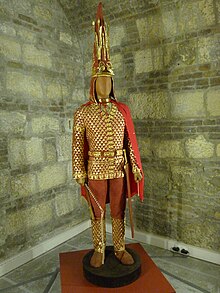Issyk kurgan

The Issyk kurgan, in south-eastern Kazakhstan, less than 20 km east from the Talgar alluvial fan, near Issyk, is a burial mound discovered in 1969. It has a height of six meters and a circumference of sixty meters. It is dated to the 4th or 3rd century BC (Hall 1997). A notable item is a silver cup bearing an inscription. The finds are on display in Astana.
"Golden man"
Situated in what was at the time eastern Scythia, just north of Sogdiana, the burial contained a skeleton of uncertain sex, in all probability an 18-year-old Saka (Scythian) prince or princess, interred with warrior's equipment, variously dubbed "golden man" or "golden princess", and with rich funerary goods, including 4,000 gold ornaments.
The "golden man" was adopted as one of the symbols of modern Kazakhstan. A likeness of the "golden man" crowns the Independence Monument on the central square of Almaty. Its depiction may be found on the Presidential Standard of Nursultan Nazarbayev.
The Issyk inscription

The inscription is in a variant of the Kharoṣṭhī script, and is probably in a Scythian dialect, constituting one of very few autochthonous epigraphic traces of that language. Harmatta (1999) identifies the language as Khotanese Saka, tentatively translating "The vessel should hold wine of grapes, added cooked food, so much, to the mortal, then added cooked fresh butter on" (compare Nestor's Cup and Duenos inscription for other ancient inscriptions on vessels that concern the vessel itself).
Photos of the inscription


References
- Hall, Mark E. Towards an absolute chronology for the Iron Age of Inner Asia. Antiquity 71 (1997): 863-874.
- Harmatta, Janos. History of Civilization of Central Asia. Volume 2, Motilal Banarsidass (1999), ISBN 81-208-1408-8, p. 421 [1][2]
Golden treasures in the kurgan





External links
